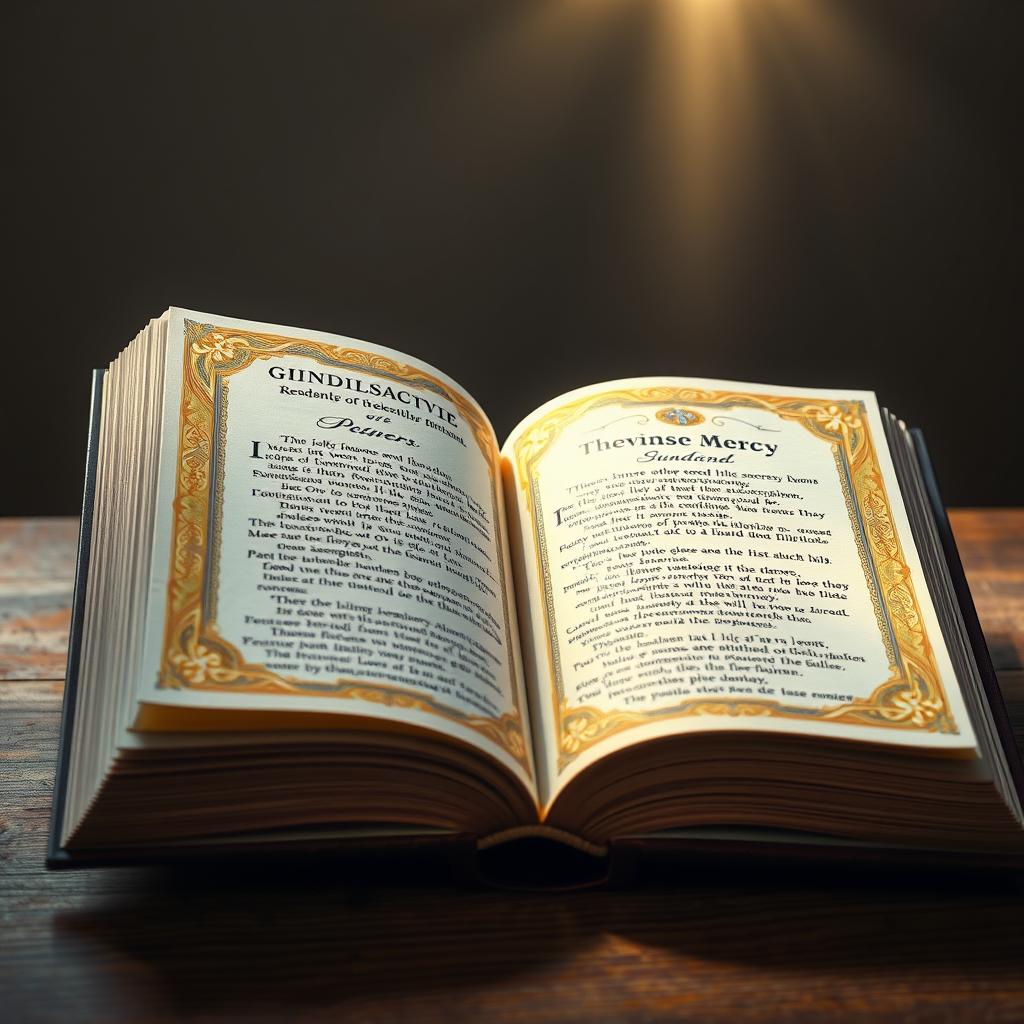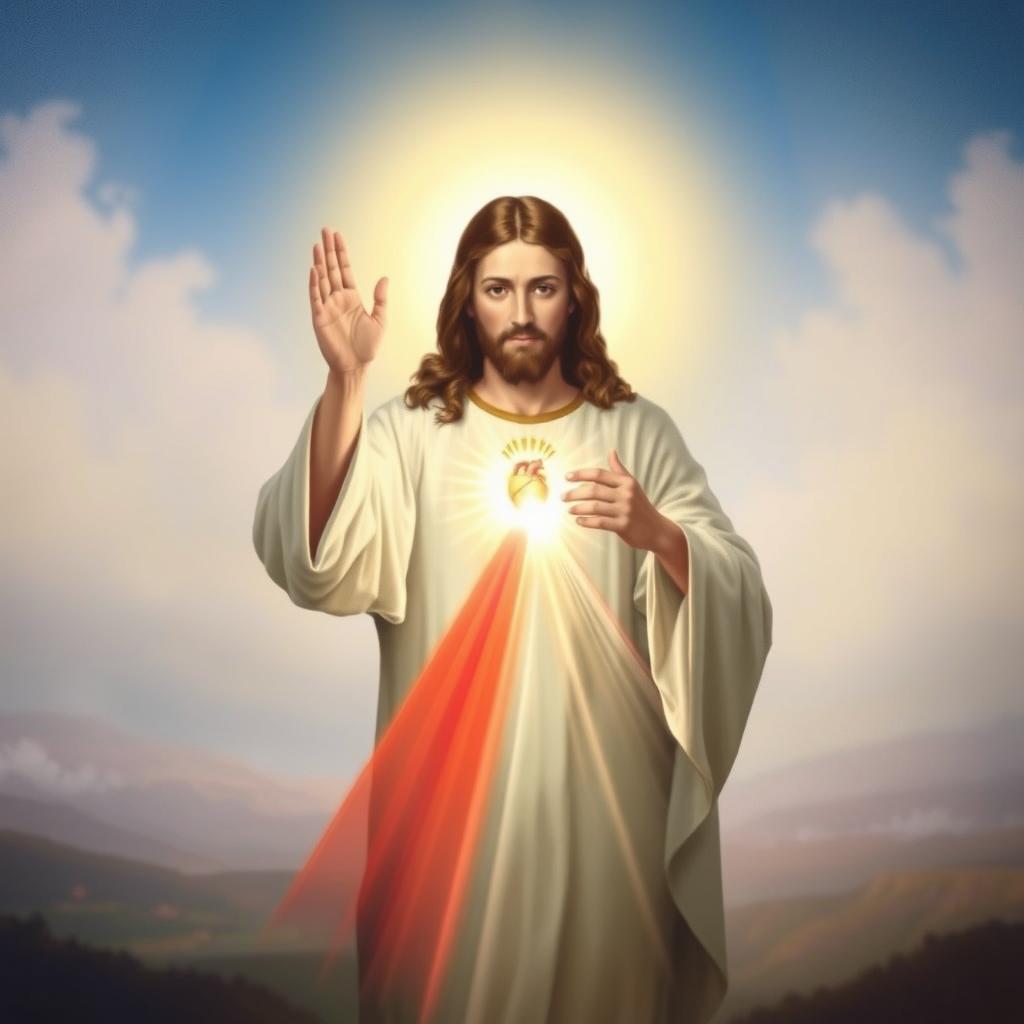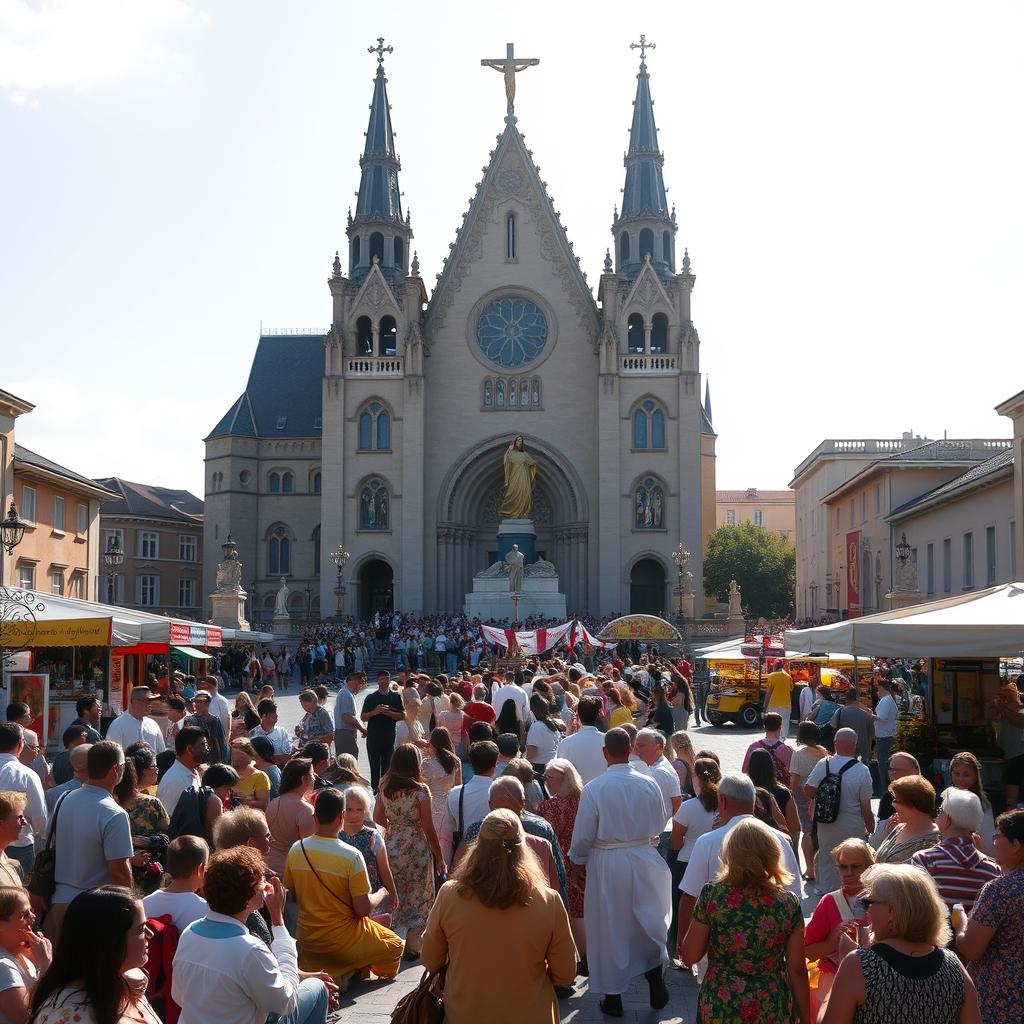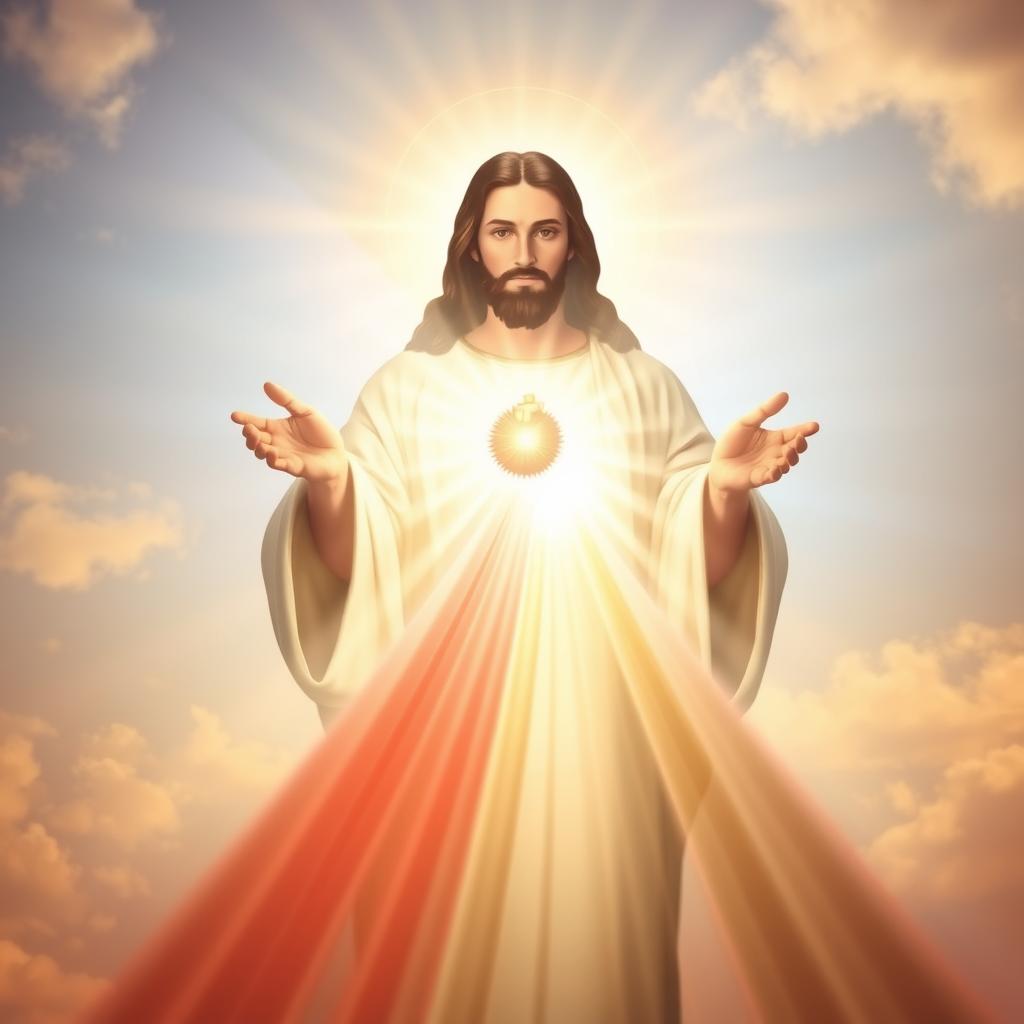The Second Sunday of Easter is a significant day in the liturgical calendar, marked by the celebration of Divine Mercy Sunday. This feast day is a powerful reminder of God’s boundless mercy and compassion.
The origins of this celebration date back to the private revelations received by St. Faustina Kowalska, a Polish nun who recorded Jesus’ messages about divine mercy in her diary during the 1930s.
The liturgy for this day beautifully illuminates different dimensions of God’s mercy through the readings from Acts 5:12-16, Psalm 118, Revelation 1:9-11a, 12-13, 17-19, and John 20:19-31, offering a profound opportunity for spiritual renewal and a deeper understanding of how God’s love can transform our daily life.
The Origin and Significance of Divine Mercy Sunday
As we delve into the significance of Divine Mercy Sunday, it’s essential to understand its origins and the pivotal role it plays in the Catholic liturgical calendar. This feast, celebrated on the Second Sunday of Easter, is a joyous occasion for Catholics worldwide to reflect on God’s merciful love.
The journey to establishing Divine Mercy Sunday as an official feast involved key figures and events. One of the central figures was St. Faustina Kowalska, a Polish nun who received profound revelations from Jesus Christ.
St. Faustina Kowalska and the Divine Revelations
St. Faustina Kowalska’s diary, Divine Mercy in My Soul, is a testament to the revelations she received, which emphasized the mercy of God and the need for humanity to trust in and spread this message of mercy. Her writings played a crucial role in shaping the devotion to Divine Mercy.
The revelations received by St. Faustina were not just personal messages but carried a universal significance, calling all people to trust in God’s mercy and to be merciful towards others. This message is at the heart of Divine Mercy Sunday.
Pope John Paul II and the Establishment of the Feast
Pope John Paul II played a pivotal role in establishing Divine Mercy Sunday as an official feast in the Church’s liturgical calendar. On April 30, 2000, during the canonization of St. Faustina Kowalska, Pope John Paul II officially designated the Second Sunday of Easter as Divine Mercy Sunday for the universal Church.
The Pope emphasized that this feast was not merely a new devotion but a rediscovery of an essential aspect of the Christian faith—God’s merciful love as revealed through Christ’s death and resurrection.
In establishing this feast, Pope John Paul II fulfilled Jesus’ request to St. Faustina and provided the faithful with a powerful annual reminder of the “Easter gift that the Church receives from the risen Christ and offers to humanity.”
The devotion to Divine Mercy Sunday grew rapidly after its designation by Pope John Paul II and is now widely celebrated by Catholics around the world. It serves as a reminder of the importance of trusting in God’s mercy and of being instruments of that mercy to others.
Understanding Divine Mercy in Scripture
Understanding Divine Mercy requires an exploration of its scriptural foundations, where God’s mercy is a recurring theme. The concept of Divine Mercy is not limited to a single testament but is a thread that weaves through the entire biblical narrative.
Mercy in the Old Testament Context
The Old Testament lays the groundwork for understanding Divine Mercy by portraying God’s character as compassionate and loving. In the Hebrew Scriptures, God’s mercy is often associated with His covenant faithfulness and steadfast love towards His people.
The Psalmist frequently invokes God’s mercy, highlighting its importance in the religious life of Israel. For instance, Psalm 136 repeatedly declares, “His mercy endures forever,” underscoring the enduring nature of God’s merciful love.

The Embodiment of Divine Mercy in Jesus Christ
In the New Testament, Jesus Christ becomes the perfect embodiment and living revelation of Divine Mercy. Through His teachings, actions, and ultimately His sacrifice, Jesus reveals the depth of God’s merciful love.
Jesus’ parables, such as the story of the Prodigal Son (Luke 15:11-32), illustrate God’s joy in forgiving and welcoming back sinners. His healing ministry demonstrated mercy in action, restoring sight to the blind, cleansing lepers, and raising the dead—physical signs pointing to the deeper spiritual healing He offers.
The ultimate expression of Divine Mercy came through Jesus’ sacrifice on the cross, where “Mercy flowed out for souls” through His pierced heart, as recorded by St. Faustina. Even from the cross, Jesus continued to embody mercy by forgiving His executioners and promising paradise to the repentant thief.
The Readings of Divine Mercy Sunday
On Divine Mercy Sunday, the liturgical readings provide a profound insight into the mercy of God as revealed through Jesus Christ. These readings are carefully selected to highlight the core message of Divine Mercy Sunday, emphasizing God’s love, forgiveness, and the gift of peace.
First Reading: Acts 5:12-16 – The Apostles’ Healing Ministry
The first reading from Acts 5:12-16 recounts the apostles’ healing ministry, where people brought their sick to be healed by the apostles, believing in the power of God working through them. This passage underscores the continuation of Jesus’ healing mission through His disciples, reflecting the merciful works of Christ.
The healing ministry of the apostles is a testament to the power of faith and the mercy that flows from it. As the people brought their sick to the apostles, it demonstrated their belief in the divine power that had been entrusted to them.

Responsorial Psalm: Psalm 118 – God’s Mercy Endures Forever
The responsorial psalm, Psalm 118, is a beautiful expression of gratitude and trust in God’s enduring mercy. The refrain, “His mercy endures forever,” is a powerful reminder of the steadfast love of God, encouraging the faithful to give thanks and praise.
Second Reading: Revelation 1:9-11a, 12-13, 17-19 – Vision of the Risen Christ
The second reading from Revelation 1 offers a vision of the risen Christ, emphasizing His glory and divine authority. This passage encourages believers to remain faithful, even in the face of adversity, by focusing on the glory and power of the risen Lord.
Gospel: John 20:19-31 – Thomas’s Doubt and Faith
The Gospel reading for Divine Mercy Sunday, John 20:19-31, recounts Jesus’ appearance to His disciples after His resurrection. Jesus’ greeting, “Peace be with you,” and His commission to the disciples to forgive sins, highlight the peace and authority that come from Him. The passage also includes the story of Thomas’s doubt and subsequent faith, illustrating the journey to belief and the significance of faith in the risen Christ.
The Gospel reading beautifully encapsulates the essence of Divine Mercy Sunday, as Jesus shows His wounds to Thomas, inviting him to touch the sources from which the rays of mercy flow. Christ’s words to Thomas, “Blessed are those who have not seen and have believed,” offer encouragement to all who celebrate Divine Mercy Sunday with faith in Jesus’ promises.
As we reflect on these readings, we are reminded of the peace that comes from trusting in God’s mercy and the graces available through the Sacrament of Reconciliation on Divine Mercy Sunday.
The Divine Mercy Image
The Divine Mercy Image, a poignant representation of Christ’s mercy, holds deep significance. It is a visual representation of Jesus’ message to St. Faustina Kowalska, emphasizing God’s mercy towards humanity.

The image is rich in symbolism, with the rays emanating from Jesus’ heart representing the life-giving and saving grace that flows from Him.
Symbolism of the Rays and Inscription
The Divine Mercy Image features two rays emanating from Jesus’ heart: a red ray symbolizing the blood of Christ and a pale ray representing the water that flowed from His side. These elements are significant as they symbolize the sacraments and the grace bestowed upon believers. The inscription “Jesus, I trust in You” is a message of faith and trust in the merciful love of Christ.
Jesus, I trust in You is more than a phrase; it’s a prayer that encapsulates the essence of devotion to the Divine Mercy.
History of the Painting and Its Veneration
The first Divine Mercy image was painted by Eugene Kazimierowski under St. Faustina’s direction in 1934. Although she was not entirely satisfied with the representation, it was the first step in spreading the devotion. The image was first venerated publicly on April 28, 1935, during the Feast of Divine Mercy, which coincided with the second Sunday of Easter. This day marked the end of the Jubilee of the Redemption called by Pope Pius XI.
Since then, the Divine Mercy Image has become a universal symbol of hope and mercy, venerated in countless churches and homes worldwide. Its significance extends beyond its aesthetic appeal, serving as a reminder of God’s infinite mercy.
Sunday of Divine Mercy Celebrations Around the World
As Divine Mercy Sunday approaches, Catholics around the world prepare to honor the boundless mercy of God through various traditions and practices. This feast has become a universal celebration, embracing diverse cultural expressions while maintaining its core spiritual elements.
The significance of Divine Mercy Sunday is not limited to its spiritual importance; it is also a day of vibrant celebrations across the globe. From solemn processions to joyful community gatherings, the day is marked with a deep sense of devotion and festivity.
Traditional Observances in Poland
In Poland, the country associated with the origins of the Divine Mercy devotion thanks to St. Faustina Kowalska, the celebrations are deeply rooted in tradition. The Divine Mercy Sanctuary in Krakow-Lagiewniki is a major pilgrimage site, attracting thousands who come to pray and participate in the liturgical celebrations.
The festivities often include the recitation of the Divine Mercy Chaplet, special Masses, and processions with the venerated image of the Divine Mercy. These observances reflect the country’s strong Catholic heritage and its embrace of the Divine Mercy message.
Global Celebrations and Practices
Divine Mercy Sunday has become a global celebration, with Catholics on every continent participating in unique and culturally rich ways. In the Philippines, for instance, massive gatherings take place in churches and stadiums, featuring continuous recitation of the Divine Mercy Chaplet and processions with beautifully adorned Divine Mercy images.

Latin America also witnesses vibrant celebrations, with processions through city streets and families bringing their own Divine Mercy images to be blessed. In the United States, the National Shrine of The Divine Mercy in Stockbridge, Massachusetts, hosts one of the largest celebrations, drawing thousands for a day of confession, Mass, and prayers culminating in the Hour of Mercy at 3:00 PM.
The global celebration of Divine Mercy Sunday is a testament to the universal appeal of God’s mercy. It is a day when people from diverse backgrounds come together, united in their faith and devotion to the merciful love of God.
Special Graces and the Divine Mercy Promise
Jesus’ promise to St. Faustina Kowalska on Divine Mercy Sunday includes the gift of complete forgiveness for those who approach the sacraments with the right disposition. This extraordinary grace is a cornerstone of the Divine Mercy devotion, emphasizing the boundless mercy of God towards humanity.
The Gift of Complete Forgiveness
The Divine Mercy Sunday offers the faithful an opportunity to obtain complete forgiveness of sins and punishment. According to Jesus’ revelation to St. Faustina, a soul that goes to Confession and receives Holy Communion on this day shall receive this complete forgiveness. This promise underscores the significance of the sacraments in the life of a Catholic, particularly on this day when the divine floodgates of grace are said to be opened.
In June 2002, Pope John Paul II granted indulgences to Catholics who recite specific prayers on Divine Mercy Sunday. The Apostolic Penitentiary formally decreed these grants, outlining specific conditions for obtaining a plenary indulgence, including participation in prayers and devotions in honor of Divine Mercy, sacramental confession, Holy Communion, and prayer for the intentions of the Pope.

Conditions for Receiving the Divine Mercy Graces
To receive the extraordinary graces promised by Jesus for Divine Mercy Sunday, one must fulfill specific conditions. First, the soul must receive the Sacrament of Confession, which can be done before the feast day, provided the person remains in a state of grace on Divine Mercy Sunday. Receiving Holy Communion on the feast day itself is also required, with an awareness of the special graces attached to this day and trust in God’s mercy.
Beyond these sacramental requirements, approaching the feast with trust in God’s mercy, performing works of mercy, and venerating the Divine Mercy image are also emphasized. Jesus told St. Faustina that He wanted the image solemnly blessed on the first Sunday after Easter and venerated publicly so that every soul may know about it. By doing so, the faithful can fully participate in the graces offered on Divine Mercy Sunday.
Devotional Practices for Divine Mercy Sunday
As Divine Mercy Sunday approaches, Catholics around the world prepare to honor the boundless mercy of God through various devotional practices. These practices are deeply rooted in the revelations received by St. Faustina Kowalska and are designed to bring souls closer to God’s infinite love.
The devotional practices associated with Divine Mercy Sunday are multifaceted and offer a meaningful way for the faithful to deepen their understanding of God’s mercy. Among these practices, the Divine Mercy Chaplet holds a special place.
The Divine Mercy Chaplet
The Divine Mercy Chaplet is a powerful prayer that reflects on the Passion of Christ and God’s mercy towards sinners. Jesus gave St. Faustina nine intentions for which to pray the Chaplet, beginning on Good Friday and ending on the Saturday before Divine Mercy Sunday. This novena of prayer prepares the faithful for the celebration of Divine Mercy Sunday.
The Chaplet is prayed using a special rosary, and its prayers emphasize the trust in God’s mercy and the recognition of Jesus’ sacrifice on the cross. By praying the Chaplet, the faithful can obtain divine mercy for themselves and others.
The Divine Mercy Novena
The Divine Mercy Novena is another significant devotional practice that precedes Divine Mercy Sunday. This novena begins on Good Friday and continues until the day before Divine Mercy Sunday. During these nine days, the faithful pray the Chaplet with specific intentions, deepening their devotion to the divine mercy of God.
The novena is a period of spiritual preparation, calling the faithful to reflect on their relationship with God and to seek His mercy. It is a time for introspection, prayer, and reconciliation.
The Hour of Mercy
The Hour of Mercy, observed at 3:00 PM, is a particularly significant moment during Divine Mercy Sunday. It is the hour when Jesus died on the cross, and it holds special significance in Divine Mercy devotion. Jesus instructed St. Faustina to pray for souls at this hour, promising that He would refuse nothing to those who pray in virtue of His Passion.

During this sacred hour, the faithful are encouraged to pray the Stations of the Cross, venerate the Divine Mercy image, or simply spend time in silent adoration, contemplating the price Jesus paid to pour out mercy upon souls. Many parishes schedule their main Divine Mercy Sunday celebrations to culminate at 3:00 PM, uniting the community in prayer at this most solemn hour.
Papal Teachings on Divine Mercy
The Papal teachings on Divine Mercy have been a cornerstone of the Catholic Church’s doctrine, emphasizing God’s infinite love and compassion. This section will explore the significant contributions of Pope John Paul II and Pope Francis to the understanding and dissemination of Divine Mercy.
The “Rich in Mercy” Encyclical
Pope John Paul II’s encyclical “Dives in Misericordia” (Rich in Mercy) is a foundational document that explores the concept of Divine Mercy. Issued on November 30, 1980, this encyclical delves into the scriptural and theological aspects of mercy, highlighting its importance in the life of the Church and the individual believer. The Pope emphasizes that God’s mercy is the ultimate source of hope for humanity, providing a path to peace and reconciliation.

Pope Francis and the Continuation of the Message
Pope Francis has continued and expanded upon the teachings of his predecessors, making mercy a central theme of his pontificate. In his bull “Misericordiae Vultus” (The Face of Mercy), Pope Francis proclaimed that “Jesus Christ is the face of the Father’s mercy,” underscoring the significance of mercy in Christian life. He has also encouraged the faithful to approach God with their weaknesses, rather than hiding them, citing Jesus’ words to St. Faustina: “I am love and mercy itself; there is no human misery that could measure up to my mercy.”
During the Jubilee Year of Mercy, Pope Francis established the “Missionaries of Mercy,” emphasizing practical ways to live divine mercy. He consistently teaches that the path to peace, both interior and in the world, comes through experiencing and extending God’s mercy to others. By doing so, believers can find a way to overcome their sin and deepen their prayer life.
As Pope Francis reminds us, “Mercy cannot become a mere parenthesis in the life of the Church; it constitutes her very existence.” This understanding of mercy as central to the Church’s life is a call to all believers to embrace and live the message of divine mercy, fostering a culture of forgiveness, compassion, and love.
Living Divine Mercy in Daily Life
Embracing Divine Mercy is not limited to a single Sunday; it’s a way of life that transforms our daily interactions. As we reflect on the significance of Divine Mercy Sunday, we’re called to consider how we can embody this mercy in our everyday lives.

The Three Degrees of Mercy
The practice of Divine Mercy is multifaceted, involving deed, word, and prayer. Deeds of mercy are tangible expressions of love and compassion, such as feeding the hungry and sheltering the homeless. These actions not only address physical needs but also reveal Christ’s compassion to those around us.
Equally important are the spiritual works of mercy, which include counseling the doubtful, instructing the ignorant, and comforting the afflicted. By engaging in these spiritual acts, we extend mercy to others on a deeper, more profound level.
Practical Ways to Extend Mercy
In our modern world, extending mercy can take many forms. It might mean being patient with others, offering a listening ear, or simply being present for someone in need. Families can become “domestic schools of mercy” by practicing forgiveness and compassionate listening at home.
“Yes, the first Sunday after Easter is the Feast of Mercy, but there must also be deeds of mercy, which are to arise out of love for Me. You are to show mercy to our neighbors always and everywhere.” — Diary 742
By living out Divine Mercy in our daily lives, we not only receive God’s mercy but also become channels of that same mercy to others. This journey of mercy is not always easy, but it is profoundly rewarding, bringing joy and peace to both the giver and the receiver.
Embracing God’s Endless Mercy
Embracing God’s endless mercy is at the heart of the Divine Mercy Sunday message, offering hope and redemption to all. This celebration, observed on the Sunday after Easter, reminds us that God’s mercy is boundless and transformative.
Divine Mercy Sunday invites us to acknowledge the limitless nature of God’s mercy, which reaches into the deepest wounds of sin and shame. As Jesus revealed to St. Faustina, “The greater the sinner, the greater the right he has to My mercy.” This profound statement underscores God’s particular concern for those most trapped in sin and despair.
The journey of embracing God’s endless mercy begins with trust—believing in God’s unconditional love, regardless of our past or present struggles. The simple prayer “Jesus, I trust in You” serves as a powerful reminder of this trust. As we celebrate Divine Mercy Sunday, we’re reminded that mercy is central to the Easter mystery, offering each soul a new life washed clean in Christ’s mercy.
This awareness of God’s mercy should overflow into our relationships, creating a ripple effect of compassion and forgiveness. In a society often marked by division and judgment, embracing and extending God’s endless mercy becomes a powerful witness to Christ’s love. As we live in the freedom of being infinitely loved, we are called to make Divine Mercy Sunday a continuous invitation to life on the First Sunday after Easter, or Sunday after Easter, a day that embodies the essence of Divine Mercy.
FAQ
What is the significance of Divine Mercy Sunday?
Divine Mercy Sunday is a celebration of God’s endless mercy and forgiveness, as revealed through Jesus Christ. It is observed on the second Sunday of Easter and is a day to reflect on the mercy of God and to seek forgiveness for sins.
Who is St. Faustina Kowalska and what is her connection to Divine Mercy?
St. Faustina Kowalska was a Polish nun who received revelations from Jesus Christ, which were recorded in her diary. Her writings and experiences are the basis for the Divine Mercy devotion, and she is considered a key figure in spreading the message of God’s mercy.
What are the conditions for receiving the Divine Mercy graces on this day?
To receive the Divine Mercy graces, one must receive Holy Communion, go to Confession, and have a devotion to the Divine Mercy. It is also recommended to pray the Divine Mercy Chaplet and to perform acts of mercy towards others.
What is the Divine Mercy Image, and what is its significance?
The Divine Mercy Image is a painting of Jesus Christ that depicts Him with outstretched arms and rays of light emanating from His heart. The image is a representation of God’s mercy and forgiveness, and it is venerated by Catholics around the world.
How can I incorporate the message of Divine Mercy into my daily life?
To live the message of Divine Mercy, one can practice acts of mercy towards others, such as visiting the sick, helping the poor, and forgiving those who have wronged them. One can also pray the Divine Mercy Chaplet and reflect on the mercy of God.
What is the Hour of Mercy, and how is it observed?
The Hour of Mercy is a devotion that involves praying at 3:00 PM, the hour of Jesus’ death on the cross. It is a time to reflect on the mercy of God and to pray for the salvation of souls.
What is the significance of the Divine Mercy Chaplet?
The Divine Mercy Chaplet is a prayer that is prayed on a rosary, and it is a powerful tool for seeking forgiveness and mercy. It is a way to reflect on the mercy of God and to ask for His forgiveness and healing.
Homily for Easter Sunday Year C: Reflections on Renewal and Hope
